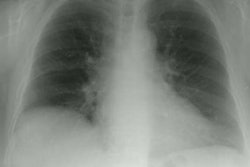AJR Am J Roentgenol 1996 Dec;167(6):1573-1578
Patients with antiphospholipid antibodies: CT and MR findings of the brain.
Provenzale JM, Barboriak DP, Allen NB, Ortel TL
OBJECTIVE: The purpose of this study was to determine the spectrum of neuroradiologic findings in patients with antiphospholipid antibodies (APA) and to compare findings in systemic lupus erythematosus (SLE) and non-SLE patients. MATERIALS AND METHODS: We identified 110 patients with APA who underwent CT or MR imaging, of whom 59 (54%) had abnormal studies. Of these 59 patients, abnormalities were categorized as large infarcts, cortical infarcts, lacunar infarcts, hyperintense white matter foci on T2-weighted images, or dural sinus thrombosis. White matter foci were designated as small (< 5mm) or large (> 5 mm). RESULTS: Large infarcts were the most common abnormality, seen in 24 of 110 (22%) patients, followed in frequency by hyperintense white matter foci, seen in 19 of 110 (17%) patients. Ninety-five percent of patients with hyperintense white matter foci had at least one large lesion, and 76% had five or more small foci, three or more large foci, or both. Small cortical infarcts and lacunar infarcts were seen in 11 of 110 (10%) and 10 of 110 (9%) patients, respectively. Dural sinus thrombosis was seen in five patients. The frequency of abnormalities was high in both the SLE (57%) and the non-SLE (41%) groups. Large infarcts were more common in the non-SLE group (26%) than in the SLE group (5%). Although hyperintense white matter foci and cortical infarcts were more common in SLE patients, the differences were not statistically significant. CONCLUSION: Infarcts of various sizes and hyperintense white matter foci are the most common abnormalities seen on CT and MR imaging in patients with APA. We found no significant differences in frequencies of abnormalities seen between non-SLE and SLE patients.
PMID: 8956600, MUID: 97115199
